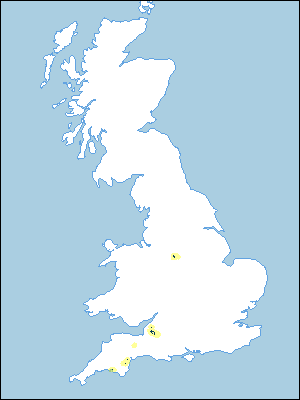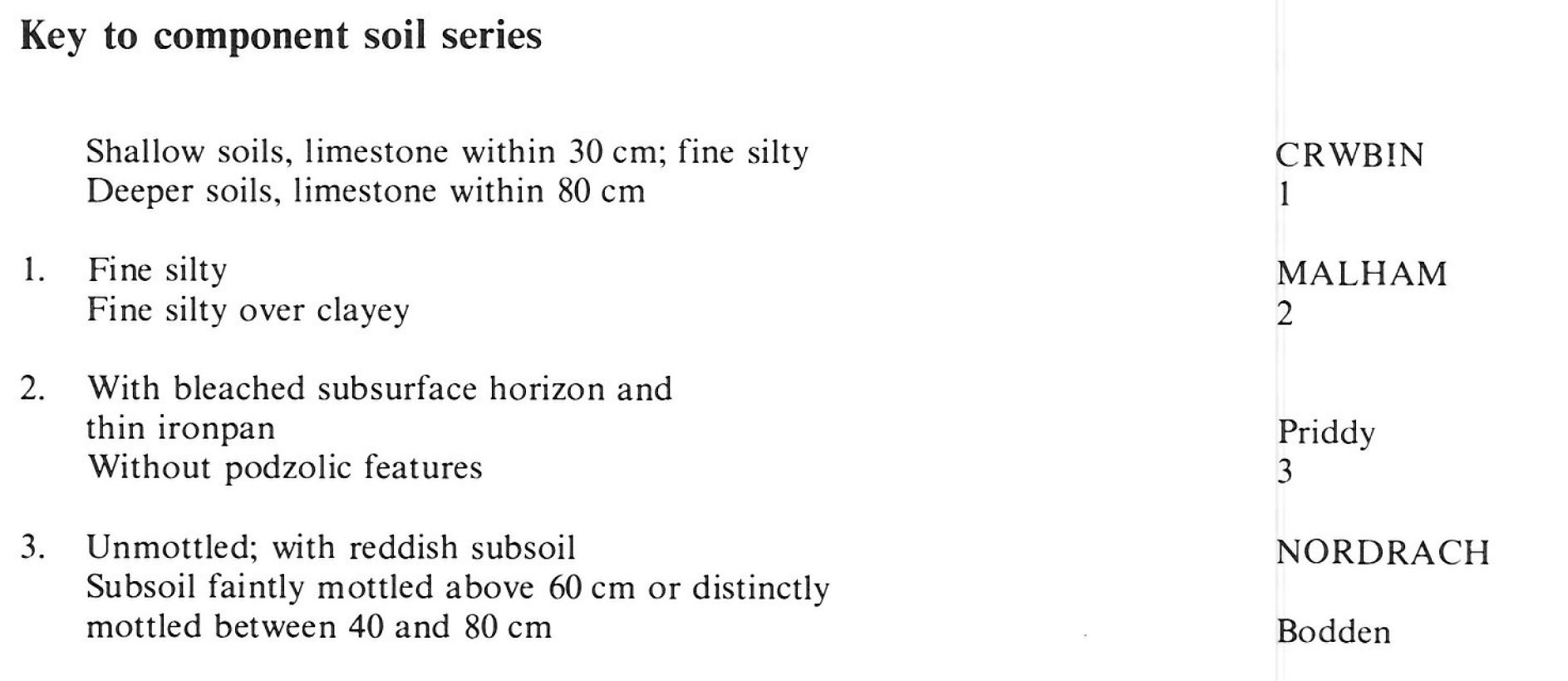
Soil Associations
0581a NORDRACH
Soil and site characteristics
Well drained fine silty over clayey soils stoneless or with chert stones, often deep. Shallow silty soils over limestone in places. Mainly on flat or gently sloping ground. Bare rock in places on brows or steeper valley sides.
Geology
Aeolian silty drift over Carboniferous limestone
Cropping and Land Use
Dairying on short term grassland; some stock rearing in Derbyshire.
Component soil series
| Subgroup | Series name | Percentage | WRB 2006 link |
|---|---|---|---|
| 5.81 | NORDRACH | 70% | Chromic Endoleptic Luvisols |
| 5.41 | MALHAM | 20% | Eutric Endoleptic Cambisols |
| 3.13 | CRWBIN | 10% | Eutric Leptosols |
Covers 143 km2 in England and Wales
Soilscapes Classification
| 7 |
Freely draining slightly acid but base-rich soils |
0581a NORDRACH
Detailed Description
The Nordrach association occurs on Carboniferous limestone in Derbyshire on the fringes of the Peak District, and on the Mendip and adjoining hills in Somerset and Avon. It is found also on small outcrops of Devonian limestone in south Devon. Except in Devon, it typically occurs on upland plateaux above 300 m O.D., where it mainly occupies flat or gently sloping land dissected by dry valleys. There is bare rock locally on brows or steeper valley sides. In east Somerset and north Dorset the association is found in the Sparkford Vale and Blackmoor Vale along tributaries of the Yeo and Stour. Between Yeovil and Castle Cary it includes much of the drift-covered lowland formerly mapped as Podimore series, and takes in patches of limestone gravels with calcareous Badsey and St Lawrence series. The bottoms of minor valleys have clayey Fladbury and Wyre soils. In the Blackmoor Vale, flinty drift is extensive on ridges crests and valley sides, here Evesham series occurs to a minor extent. There are small scattered occurrences in Wiltshire in the Nadder valley near Tisbury, in Greensand drift, and near Salisbury where the soils are mapped in drift from Tertiary rocks over London Clay.
On the Mendip plateau, most Malham and Crwbin soils were mapped with the Mendip Complex or Lulsgate series. Also included are soils with dark coloured humose topsoils containing rusty fragments of ironpan, below which there may be a thin bleached layer. These are remnants of Priddy soils, ironpan stagnopodzols, usually developed under former heath vegetation where drift is thick and stony. Where the subsoil clay is thickest, for example north of Shepton Mallet on Lower Limestone Shales, or locally, filling solution depressions, it is usually mottled grey and yellowish brown and contains black ferri-manganiferous deposits. These stagnogleyic features are caused by slow permeability and distinguish Bodden from Nordrach series. On the limestone near Newton Abbot and east of Plymouth at altitudes of 75 to 100 m O.D. the landscape is flat and dissected by dry valleys. Here the soils are more clayey than on the Mendips and there are Torbryan and Ogwell soils. The dry valleys contain deep silty Ipplepen soils, also described by Clayden, in drift derived from neighbouring slate outcrops.
Soil Water Regime
Nordrach, Malham and Crwbin soils are permeable and well drained (Wetness Class I). Bodden soils are occasionally waterlogged (Wetness Class II). Where untreated, Priddy soils are subject to surface wetness, but widespread mixing of the topsoil and breaking the ironpan by cultivation considerably reduces waterlogging. Excess winter rainfall readily passes through the soils into the jointed, permeable rock beneath.
Cropping and Land Use
Although the soils are well drained, easily cultivated and have good reserves of water, few arable crops are grown. This is because the land is relatively high and rainfall, humidity and cloud-cover discourage cropping. In the past, mining activities limited agricultural improvement and caused extensive pollution by lead and zinc fumes and spoil. The effects of pollution are now rarely seen though infertility and other animal ailments are sometimes attributed to metal toxicity. With piped water supplies, in what is naturally a waterless landscape, heavy stocking is possible with little risk of poaching and grass yields can be large. Successful hay making is difficult in this climate, so silage making is common, sometimes as bales. For cereal crops, the soil is easily prepared and drilled and with liming and balanced general fertilizers good yields might be expected. Mildew and other cereal diseases however, are common and harvesting is often delayed. Potatoes, which crop well, were formerly grown on the Mendip plateau, often in hand-dug allotments on a rented basis. Coniferous plantations are common particularly on and around mined ground, although yields might be expected to be above average on these deep soils, exposure on the plateau top is a limiting factor. A wide range of species have been planted though only Scots pine (Pinus sylvestris) and beech (Fagus sylvatica) yield above the regional mean. Early plantings suffered from rabbit and squirrel damage and mineral toxicity from excessive zinc leading to manganese deficiency. In Devon the shallower soils are rather droughty. This limitation together with rockiness and variable slope means that there is little arable land and most is in permanent grassland and woodland.
0581a NORDRACH
Distribution Map
 |
Note that the yellow shading represents a buffer to highlight the location of very small areas of the association.
Keys to component soil series
South Western Region
 |
All information Copyright, Cranfield University © 2025
Citation: To use information from this web resource in your work, please cite this as follows:
Cranfield University 2025. The Soils Guide. Available: www.landis.org.uk. Cranfield University, UK. Last accessed 04/04/2025
